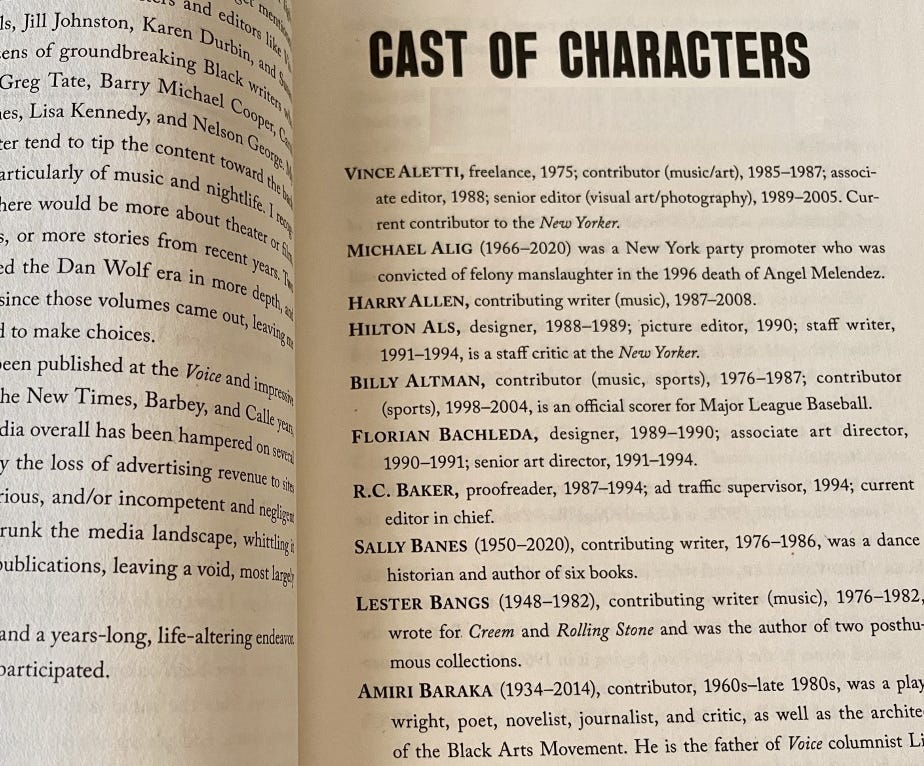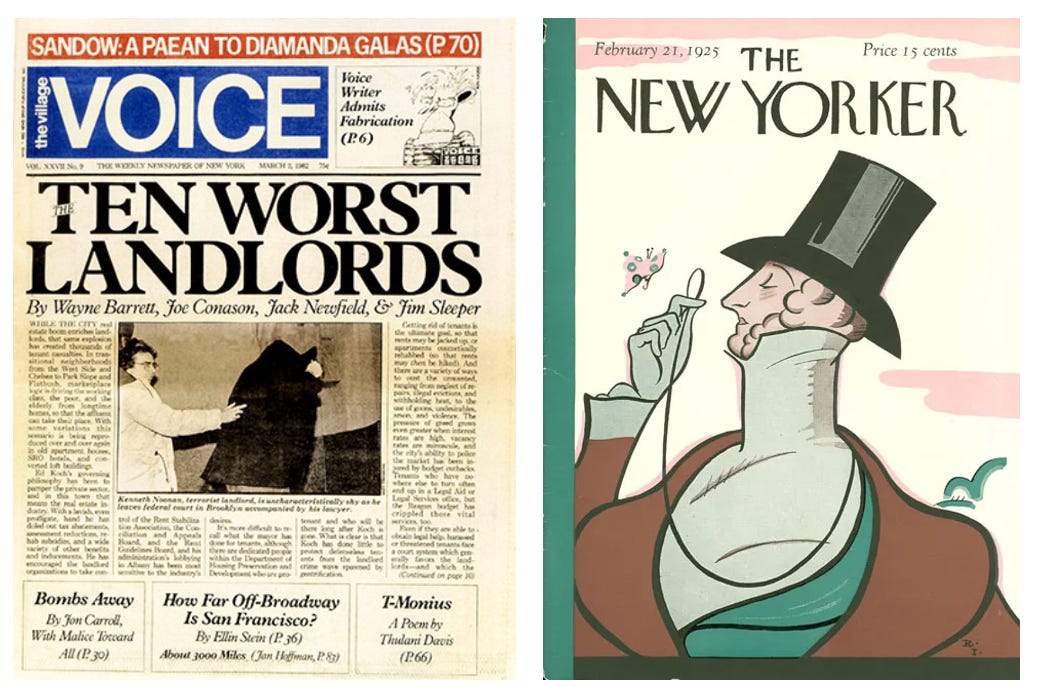The Rise and Fall of The Village VoiceA new book reminds us what we lost when the counterculture disappearedAt the start of her oral history of The Village Voice, author Tricia Romano provides a “cast of characters.” It goes on for 15 pages, and includes 216 people—each with some connection to the alternative newspaper. Many people nowadays have never lived in a society with such a vibrant counterculture. In a time when official sources all seem part of a predictable Disney-fied monoculture, just reading this list of names and mini-bios can be a revelation. Many of these individuals are now revered as historic figures who changed society. They had power and prestige. It’s easy to forget that most of them operated as outsiders. That’s how they wanted it. If you want to support my work, click here to upgrade to a premium subscription (for $6 per month).These renegades at The Village Voice knew that working outside the system—and typically against the system—was their superpower. They could criticize ruling institutions. They could speak harsh truths. They could go against the grain. One thing’s is certain: They didn’t align their interests with globalist corporate CEOs, billionaire technocrats, the surveillance state, and establishment bureaucracies. They would have laughed at journalists who did that—believing, rightly, that honest media requires distance, or even an adversarial stance, vis-à-vis entrenched powers. Because that’s what a counterculture does. That’s what it’s expected to do.
Romano captures the peculiar vibe in the title of her book The Freaks Came Out to Write. She makes clear that The Village Voice wasn’t The New York Times and it definitely wasn’t The New Yorker. Nobody ever stepped into its madcap offices and said “Ah, the Gray Lady.” No reader ever picked up a copy and expected to see Eustace Tilley on the cover. And The Voice was heard. Even establishment insiders knew they needed to listen to these ‘Freaks’. Sometimes they feared The Voice, sometimes they secretly agreed with it, but they always treated it as a force deserving respect. Until recently that’s how it worked. The tension between insiders and outsiders was a source of creative energy in society. The upstarts provided alternative views and new ideas. They kept everybody accountable. I’m pointing this out because this no longer happens. This is the world we’ve lost. Today we still have alternative views and alternative platforms. Substack—the platform where I publish The Honest Broker—is one of them. And there are many of others. But the mainstream typically views these alternative voices with indifference, neglect, or outright hostility—often working to delegitimize them. Every article I’ve read about Substack in the mainstream press has been a hit piece. And other outsider platforms don’t even get attacked—some alt media stars have an audience in the millions (or tens of millions), but their names are never mentioned by the monoculture. They’re not even outsiders, more like exiles. I’m not exaggerating when I say there’s a war going on between the macroculture and these alternative platforms. So I read Romano’s history of The Village Voice with a little nostalgia and a lot of envy. We need something like The Voice today. The system ought to support critics of the system—if only to ensure its own heath and survival. These oral histories show how things once worked. Here’s a little taste:
When did The Voice lose its way? As a music fan, I might point to 2006 when Robert Christgau and eight other members of the arts staff got fired. Or maybe the forced departure of Nat Hentoff in 2008 was the final straw. (Full disclosure: I hired Hentoff to write for me at Jazz.com a few days later.) But, in all fairness, The Village Voice could have survived these changes, just as it had survived the death of Lester Bangs or Stanley Crouch’s exit (after a violent altercation on the premises). They just needed to find the next great writer to fill the empty big shoes. They couldn’t do it. The world had changed. Borrowing the melody of a Brazos River cane-cutting song, I’m forced to sing. Taint no more print readers in the Village demographic. The Village Voice lasted a few years longer as a print newspaper, but that stopped in 2017. Today the periodical exists online, and occasionally in print, but don’t be fooled. The name may be the same but the magic is long gone. But, Lordy, those outsiders are everywhere now. They are submerged in alt platforms—and will never win Pulitzer Prizes, MacArthur Fellowships, or other perks of insiderdom. But the audience is paying attention. They don’t need to see validation from elites—that would actually make them suspicious. Much like readers of The Village Voice in the 1960s, they trust the outsider more than the insider. The only people who haven’t figured this out yet are the entrenched insiders. They think these pesky rivals working out of their apartments will just go away. It’s not going to happen. The opposite is taking place. Sure, the quality is mixed in the alt media. But if you pick wisely, you reap the benefits—that’s the single best way of replicating The Village Voice in a world where alt newspapers have disappeared. In fact, there’s a whole flourishing media ecosystem out there on podcasts and video channels and Substacks, etc. The only difference is that the monoculture doesn’t want you to know that these alternatives even exist. Maybe they can’t hide them—that’s impossible because some individual alt media stars now have more subscribers than the Gray Lady and Eustace Tilley combined—but institutional insiders can, perhaps, slow these upstarts down with hit pieces and smug dismissals. That’s why the alt voices aren’t even called a counter-culture. Just whispering the word would give them too much legitimacy. But in a media ecosystem where entrenched interests do the legitimizing, it might just be wiser to operate without it. You're currently a free subscriber to The Honest Broker. For the full experience, upgrade your subscription. |
Search thousands of free JavaScript snippets that you can quickly copy and paste into your web pages. Get free JavaScript tutorials, references, code, menus, calendars, popup windows, games, and much more.
The Rise and Fall of The Village Voice
Subscribe to:
Post Comments (Atom)
When Bad People Make Good Art
I offer six guidelines on cancel culture ͏ ͏ ͏ ͏ ͏ ͏ ͏ ͏ ͏ ͏ ͏ ͏ ͏ ͏ ͏...
-
code.gs // 1. Enter sheet name where data is to be written below var SHEET_NAME = "Sheet1" ; // 2. Run > setup // // 3....





No comments:
Post a Comment